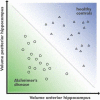Diagnostic neuroimaging across diseases
- PMID: 22094642
- PMCID: PMC3420067
- DOI: 10.1016/j.neuroimage.2011.11.002
Diagnostic neuroimaging across diseases
Abstract
Fully automated classification algorithms have been successfully applied to diagnose a wide range of neurological and psychiatric diseases. They are sufficiently robust to handle data from different scanners for many applications and in specific cases outperform radiologists. This article provides an overview of current applications taking structural imaging in Alzheimer's disease and schizophrenia as well as functional imaging to diagnose depression as examples. In this context, we also report studies aiming to predict the future course of the disease and the response to treatment for the individual. This has obvious clinical relevance but is also important for the design of treatment studies that may aim to include a cohort with a predicted fast disease progression to be more sensitive to detect treatment effects. In the second part, we present our own opinions on i) the role these classification methods can play in the clinical setting; ii) where their limitations are at the moment and iii) how those can be overcome. Specifically, we discuss strategies to deal with disease heterogeneity, diagnostic uncertainties, a probabilistic framework for classification and multi-class classification approaches.
Copyright © 2011 Elsevier Inc. All rights reserved.
Figures
References
Publication types
MeSH terms
Grants and funding
LinkOut - more resources
Full Text Sources
Other Literature Sources
Medical



